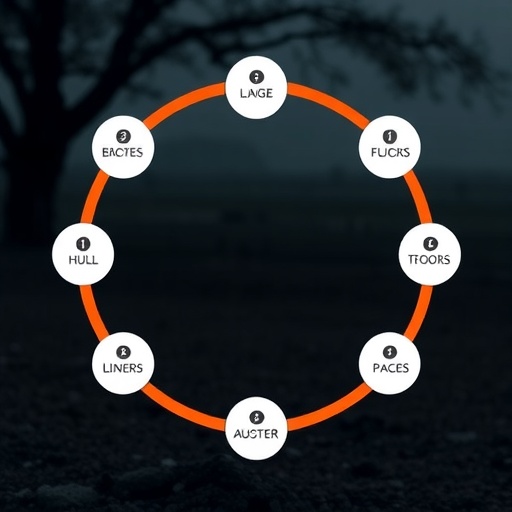In a groundbreaking study published recently in the International Journal of Legal Medicine, researchers have reported the identification of an unusually large off-ladder allele at the D21S2055 locus during population genetics analyses. This discovery carries profound implications for forensic genetics and the broader understanding of human genetic variation, particularly when it comes to the interpretation of STR (short tandem repeat) loci used in forensic investigations.
The D21S2055 locus, located on chromosome 21, is one of several STR loci commonly used for individual identification in forensic contexts. STR markers are highly polymorphic DNA sequences where a specific core sequence is repeated multiple times; their variability in repeat number across individuals makes them incredibly useful for distinguishing genetic profiles. Typically, alleles at these loci fall within a known size range cataloged in allelic ladders and reference databases. However, this study reports an anomalously large allele that falls outside the standard ladder, creating a novel challenge and opportunity for forensic genetics.
Researchers Lin, Zhang, Chen, and colleagues conducted a population-wide screening utilizing capillary electrophoresis techniques to analyze DNA fragments amplified from the D21S2055 locus. During this process, they identified an allele that exhibited an electrophoretic size considerably larger than the highest known alleles cataloged for this locus. Such off-ladder alleles are rare but crucial to document as they can affect the accuracy of forensic DNA profiling, especially in criminal casework and paternity testing where precise allele calls are essential.
Technically, the detection of this off-ladder allele required careful optimization of PCR conditions and electrophoresis parameters to ensure that the amplified fragments were accurately sized. Off-ladder alleles can result from complex repeat structures, insertions, or other sequence anomalies, often evading standard genotyping algorithms. The study delved into the molecular architecture of this allele through sequencing, confirming that it contained an expanded number of repeat units and unique sequence interruptions, distinguishing it from known alleles.
The implications of discovering a large off-ladder allele in a forensic context are multifaceted. First, it underscores the necessity to continuously update STR databases and allelic ladders to encompass such unprecedented genetic variants. Misclassification or failure to identify such alleles can lead to false exclusions or inclusions in forensic identity assessments. Second, understanding the structural nature of these alleles enriches genetic databases that support population genetics, kinship analyses, and ancestry determination.
Population genetics analyses conducted as part of the study revealed that this large allele is rare but present among certain demographic groups. The allele’s frequency and distribution patterns suggest it may arise from localized mutational events or specific evolutionary pressures acting on chromosome 21. This finding contributes to ongoing efforts to map human genetic diversity more comprehensively, which has repercussions both for evolutionary biology and practical forensic applications.
Moreover, the study highlights challenges forensic laboratories face when encountering off-ladder alleles. Many forensic genotyping platforms rely heavily on automated allele calling against standardized ladders. Off-ladder alleles may trigger flags or require manual review, slowing workflows and necessitating expert interpretation. The documentation of well-characterized off-ladder alleles like this one will improve training and software algorithms, leading to more reliable genotype calls in complex cases.
This discovery is also timely given the increasing reliance on DNA-based forensics worldwide. As forensic applications expand to include more diverse populations and complex casework, identifying and characterizing rare alleles ensures the robustness and fairness of genetic evidence. The presence of unexpected allelic variants necessitates vigilance to avoid misinterpretation, which could have significant legal consequences.
The structural analysis of the large off-ladder allele included sequence alignments that revealed a distinctive pattern of repeat expansions and possibly novel motifs within the STR sequence. This could indicate a previously unreported mutational mechanism or a recombination event unique to this locus. The authors propose future research avenues focused on the mechanistic origins of such ultra-large alleles and their potential phenotypic correlations, if any.
Furthermore, the study’s methodological rigour, combining capillary electrophoresis with sequence-level analyses, sets a new standard for forensic genetic research. While size-based electrophoretic methods remain predominant due to their speed and cost-effectiveness, sequence confirmation is invaluable for complex alleles. Integrating these approaches improves the accuracy and interpretative power of forensic genetic testing.
In light of this discovery, forensic databanks and commercial genotyping kits may need to adapt to account for large alleles like the one described. Expanding allele libraries and validating new size standards will be necessary to ensure that laboratories worldwide can reliably detect and interpret such variants without confusion or error.
Additionally, this finding holds significance beyond forensic genetics. As loci like D21S2055 are also used in population and evolutionary studies, recognizing structural novelty enhances the understanding of human genome dynamics. It also underscores the complexity of STR mutation processes, contributing to broader genetic research themes including genome stability and mutation rate variability.
The discovery of a large off-ladder allele at the D21S2055 locus exemplifies the dynamic and ever-evolving landscape of human genetic variation. It challenges existing forensic paradigms and encourages continued innovation in genotyping technologies and interpretative frameworks. As genetic science advances, such findings remind us that nature’s variability often extends beyond current reference models, calling for constant refinement in both research and applied contexts.
Ultimately, the work by Lin and colleagues paves the way for forensic genetics to embrace these rare but impactful genetic variants with greater confidence, enhancing the precision and reliability of DNA profiling globally. This has profound implications for justice, identity verification, and the expanding frontiers of human genetics.
Subject of Research: The identification and characterization of a large off-ladder allele at the D21S2055 STR locus during population genetics analysis.
Article Title: Identification of a large off-ladder allele of the D21S2055 locus during population genetics analysis.
Article References:
Lin, H., Zhang, S., Chen, D. et al. Identification of a large off-ladder allele of the D21S2055 locus during population genetics analysis. Int J Legal Med (2025). https://doi.org/10.1007/s00414-025-03624-w
Image Credits: AI Generated
Tags: anomalous allele discoverycapillary electrophoresis techniqueschromosome 21 genetic markersD21S2055 large off-ladder alleleDNA profiling challengesforensic DNA analysisforensic genetics implicationsgenetic variation in forensicsindividual identification methodspopulation genetics studyshort tandem repeat analysisSTR locus identification





